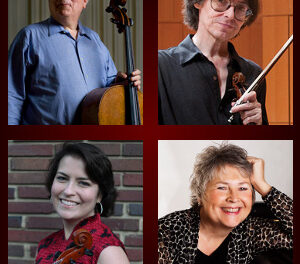The last of this season’s chamber music concerts at the Brevard Music Festival featured just two works: Mozart’s Serenade for Winds in E flat, K. 375 and Miklós Rózsa’s Piano Quintet in F minor, Op. 2.
The Mozart Serenade was originally composed in 1781 for two clarinets, two bassoons and two French horns, but a year later Mozart revised the work, adding two oboes. The 1782 version for octet was performed at this concert with four faculty members joined by four students (marked by *): Eric Ohlsson and Elizabeth Hebert,* oboes; Steve Cohen and Danny Mui,* clarinets; William Ludwig and Rachel Frederiksen,* bassoons, and Gabrielle Finck and Joseph Cradler,* French horns. The work is in five movements, with Allegros first and last, Menuettos in second and fourth place, and a central Adagio.
By the end of this week, Brevard Music Festival will have presented heaven knows how many hundreds of individual works, and it is inevitable that not every piece at every concert will be outstanding. This performance of the Mozart was competent but stiff. The minuets, in particular, seemed perfunctory and lifeless. Only in the Adagio did the performers give us the depth that one expects of Mozart. This central slow movement took on the character of an operatic ensemble, as it should.
When Miklós Rózsa was a 21-year-old student in Leipzig, Breitkopf and Härtel bought and published two of his student compositions: the String Trio, Op. 1, and the Piano Quintet, Op. 2. No doubt agents of the venerable publishing firm were impressed by the way Rózsa incorporated Hungarian folk music while honoring the German musical tradition that he was successfully mastering at the Leipzig Conservatory in that year of 1928. Continuing to show the breadth of his musical vision, Rózsa went on to be one of the masters of movie music in London and then (when World War Two began in 1939) in Hollywood. Three of his scores were nominated for the 1945 Oscars. Spellbound won, edging out The Lost Weekend and A Song to Remember. (Perhaps it was his use of the theremin in Spellbound?) Rózsa won two more Oscars later in his career, but never stopped composing concert music. He negotiated a Hollywood contract that allowed him three months off for that pursuit.
The first movement of the Piano Quintet is labeled Allegro non troppo, ma appassionato, and passionate it is. It begins with a bang – some Sturm und Drang on the piano – and then a beautiful Hungarian theme on viola. The second movement is marked Molto Adagio – the young student communicated his intentions with detailed and precise markings. In this movement, as in the first, the cello and viola get to introduce many of the gorgeous themes. The third movement Allegro capriccioso allows the players to indulge in what sounds like Hungarian chitchat, and the final movement Vivace gives all the players a vigorous workout.
Five faculty members performed the work: Jonathan Carney and Jay Christy, violins; Maggie Snyder, viola, Susannah Chapman, cello and Min Kwon, piano. Their ensemble and coordination was admirable. The string players produced color on demand and Kwon once again showed that she is a gem of a partner in chamber music. It was a delight to see many students in the Porter Center broadening their knowledge of the repertoire and assimilating lessons from this very skilled performance. I hope they left the hall, as I did, with Hungarian folk songs resonating in their heads.











